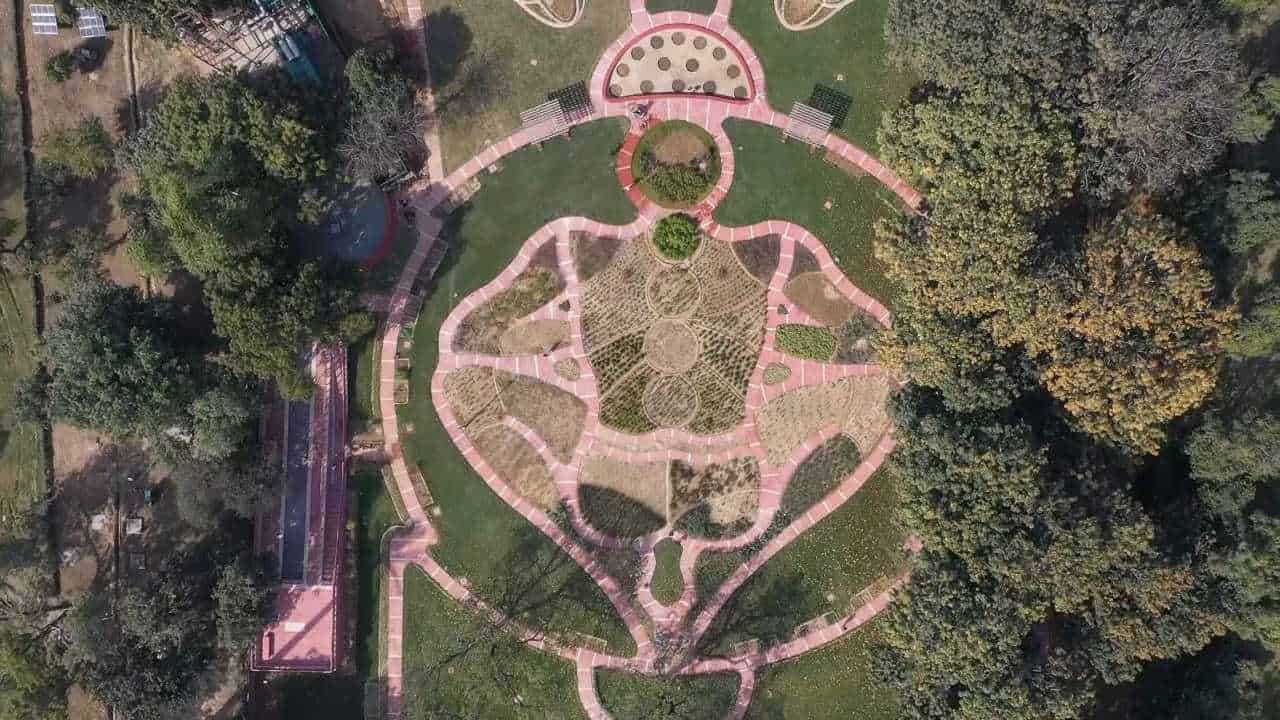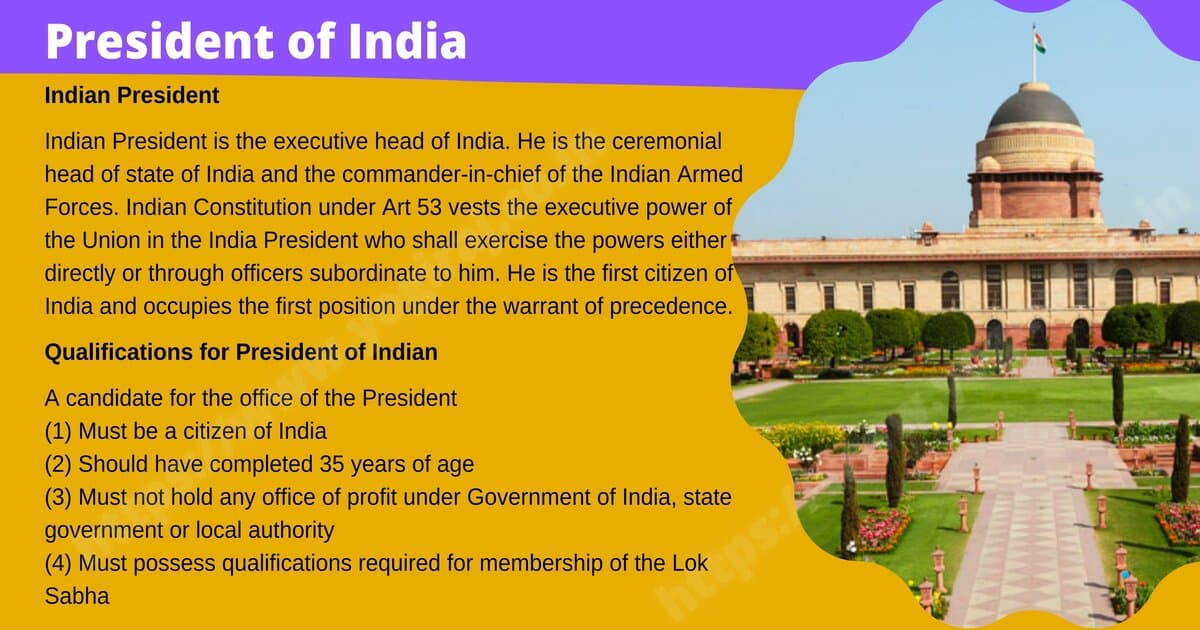President of India
by Yuvi - March 17, 2021
Indian President
Indian President is the executive head of India. He is the ceremonial head of state of India and the commander-in-chief of the Indian Armed Forces. Indian Constitution under Art 53 vests the executive power of the Union in the India President who shall exercise the powers either directly or through officers subordinate to him. He is the first citizen of India and occupies the first position under the warrant of precedence.
Qualifications for President of Indian
A candidate for the office of the President
(1) Must be a citizen of India
(2) Should have completed 35 years of age
(3) Must not hold any office of profit under Government of India, state government or local authority
(4) Must possess qualifications required for membership of the Lok Sabha
Election of President of India
The President of India is indirectly elected through an electoral college consisting of the elected members of both the houses of the Parliament and elected members of all the State Legislative Assemblies. The election is held through the system of proportional representation by means of a single transferable vote.
Terms and Emoluments of President of India
The President of India holds office for a term of five years from the date on which he enters the office. He is eligible for re-election but generally the President does not hold office for more than two terms. As per President’s Emoluments and Pension Act, 2008 (28 of 2008) which was made effective from 30.12.2008, the Indian President receives a salary of Rs.1,50,000 (One lakh fifty thousand rupees) per month. In addition to this, he is entitled to other allowances and privileges including free official residence. On retirement the Indian President is entitled to a pension at the rate of fifty per cent of the emoluments per month.
Impeachment of Indian President
The President of India can be removed from office before expiry of his term through impeachment. He can be impeached only for the violation of the Constitution and this power is vested in the Parliament. Impeachment proceedings can be initiated by either house of the Parliament.
However, in order that a charge is preferred by a house it is necessary that:
(a) a resolution containing the proposal of the charge of violation is moved after a 14-day notice in writing signed by not less than one fourth of the total membership of the House levying the charge, and
(b) the resolution is passed by a majority of not less than two-thirds of the total membership of the same house. The other House then investigates into the matter and, if a resolution is passed in that House by not less than two-thirds of its total membership substantiating the charge, the President is removed from his office.
Vacancy of Indian President
In case the office falls vacant due to the death, resignation or removal of the incumbent, the Vice- President acts as President of India. In case the Vice –President is also not available to discharge the duties of the office of the President, the Chief Justice of India acts as President.
Powers and functions of President of India
The powers and functions of Indian President can be discussed under the following heads:-
(a) Administrative Powers of Indian President –
All the executive functions of the Union are carried on in the name of the President.
The Indian President has the power to appoint
(1) The Prime Minister
(2) Other ministers of the Union
(4) The Comptroller and Auditor–General
(5) The Judges of the Supreme Court and High Courts
(6) The Governor of a state
(7) The Finance Commission
(8) The Chief Election Commissioner and other members of the Election Commission
(9) A special officer for the Scheduled Castes and Tribes.
(b) Military Powers of Indian President-
The President of India is the Supreme Commander of the Armed Forces. He has the power to declare war and peace. But his military powers are subject to the regulation of law.
(c) Legislative powers of Indian President-
The President of India is an integral part of the Parliament.
1. Summoning and proroguing Parliament and dissolving Lok Sabha.
2. Making nominations of 12 members to the Rajya Sabha and of 2 to the Lok Sabha.
3. Delivering inaugural address and sending message to the Parliament.
4. Exercising veto powers over non- money bills — absolute as well as suspensive.
5. Giving prior permission of introducing certain kinds of bills in Parliament.
6. Promulgating an ordinance.
7. Causing presentations to the Parliament reports and recommendations of various Commissions
8. Exercising absolute veto power over State legislation.
(d) Financial powers of Indian President –
(1) All money bills can originate in the Parliament only on the recommendation of the President.
(2) Keeping control over Contingency Fund of India.
(3) Causing presentation of Budget in the Parliament.
(4) Making appointment of Finance Commission.
(e) Judicial powers of Indian President –
The President of India appoints the Chief Justice and Judges of the Supreme Court and State High courts. He can grant pardon, reprieve, respite or remission of punishment or commute the sentence of any person punished under the union law. The President enjoys legal immunity and is not answerable to any court of law for anything done in the exercise of his official duties.
(f) Emergency powers of Indian President-
The Constitution vests extraordinary powers in the Indian President to deal with three types of emergencies:-
(i) Emergency due to external aggression or internal revolt (Art.352)
(ii) Emergency arising out of failure of constitutional machinery in the state (Art. 356) and
(iii) Emergency arising from threat to the financial stability or credit of the country (Art 360).
(iv) Diplomatic Powers- Indian President represents the country in international fora. He sends ambassadors to foreign countries and receives their diplomats. All international treaties and agreements are concluded on behalf of the President.
Position of Indian President
The Indian Constitution envisages a parliamentary form of government. Under such a system the President is the head of the State but not the head of the government. The Head of the government is the Prime Minister.
Though the executive powers are vested in the President, he is constitutionally obliged to exercise his executive powers with the aid and assistance of the council of ministers.
Parliamentary form of government therefore is that in it the head of the State is the constitutional or formal head and the real executive powers are vested in the Council of Ministers headed by the Prime minister responsible to the lower house (Lok Sabha).
Earlier there was no provision in the Constitution of India which made the advice of the council of ministers obligatory on the President. However, after the 42nd Amendment Act 1976, the advice if the Council of Ministers is constitutionally binding on the resident.
| Important facts about President of India | |
|---|---|
| Who is the executive head of India | The President is the executive head of India |
| Who is the President of India | Draupadi Murmu is the President of India, she sworn in as the 15th President of India on 25 July 2022 |
| Who was the first women President of India | Smt Pratibha Devisingh Patil was the first woman to have been elected to this august office. She was the 12th President of India and assumed office on July 25, 2007. |
| How is the President of India elected | President of India is elected by the members of an electoral college which consists the elected members of the Legislative Assemblies of States, elected members of both the Houses of Parliament and the Union Territories of Delhi and Pondicherry. |
| Who is the current President of India | Draupadi Murmu is the current President of India |
| Who appoints the President of India | There is no appointing authority to appoint the Indian President. President of India is indirectly elected by the members of an electoral college |
| Who is the first woman President of India | Smt Pratibha Devisingh Patil is the first woman President of India. She is the 12th President of India and assumed the office on July 25, 2007. |
| List of former Presidents of India | |
|---|---|
| Who is the fifteenth President of India | Draupadi Murmu will sworn in as the 15th President of India on 25 July 2022 |
| Who is the fourteenth President of India | Shri Ram Nath Kovind sworn in as the 14th President of India on 25 July 2017 |
| Who was the thirteenth President of India | Shri Pranab Mukherjee was the 13th President of India, held office from 25 July, 2012 to 25 July, 2017 |
| Who was the twelfth President of India | Smt Pratibha Devisingh Patil was the 12th President of India, she held office from 25 July, 2007 to 25 July, 2012 |
| Who was the eleventh President of India | DR. A.P.J. Abdul Kalam was the 11th President of India, held office from 25 July, 2002 to 25 July, 2007 |
| Who was the tenth President of India | Shri K. R. Narayanan was the 10th President of India, held office from 25 July, 1997 to 25 July, 2002 |
| Who was the ninth President of India | Dr Shankar Dayal Sharma was the 9th President of India, held office from 25 July, 1992 to 25 July, 1997 |
| Who was the eighth President of India | Shri R Venkataraman was the 8th President of India, held office from 25 July, 1987 to 25 July, 1992 |
| Who was the seventh President of India | Giani Zail Singh was the 7th President of India, held office from 25 July, 1982 to 25 July, 1987 |
| Who was the sixth President of India | Shri Neelam Sanjiva Reddy was the 6th President of India, held office from 25 July, 1977 to 25 July, 1982 |
| Who was the fifth President of India | Dr. Fakhruddin Ali Ahmed was the 5th President of India, held office from 24 August, 1974 to 11 February, 1977 |
| Who was the fourth President of India | Shri Varahagiri Venkata Giri was the 4th President of India, he held office from 3 May, 1969 to 20 July, 1969 and 24 August, 1969 to 24 August, 1974 |
| Who was the third President of India | Dr. Zakir Husain was the 3rd President of India, held office from 13 May, 1967 to 3 May, 1969 |
| Who was the second President of India | Dr. Sarvepalli Radhakrishnan was the 2nd President of India, and held office from 13 May, 1962 to 13 May, 1967 |
| Who was the first President of India | Dr. Rajendra Prasad was the 1st President of India, and he held office from 26 January, 1950 to 13 May, 1962 |













